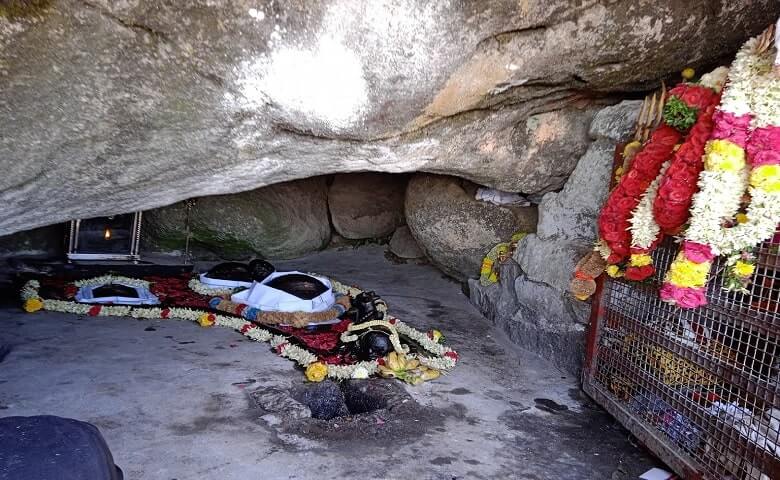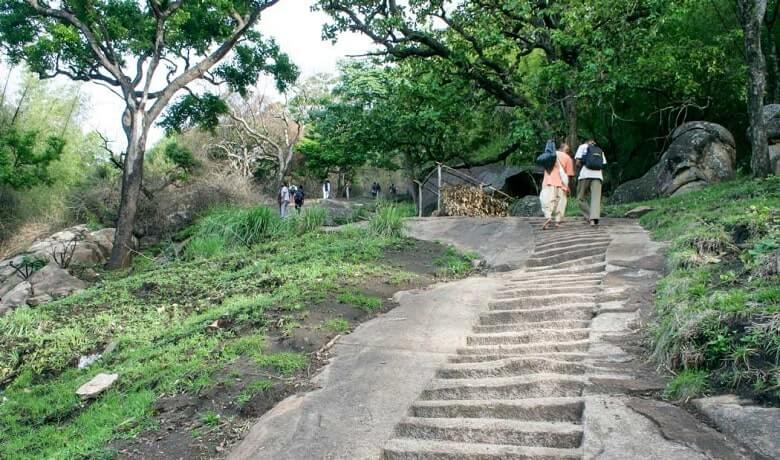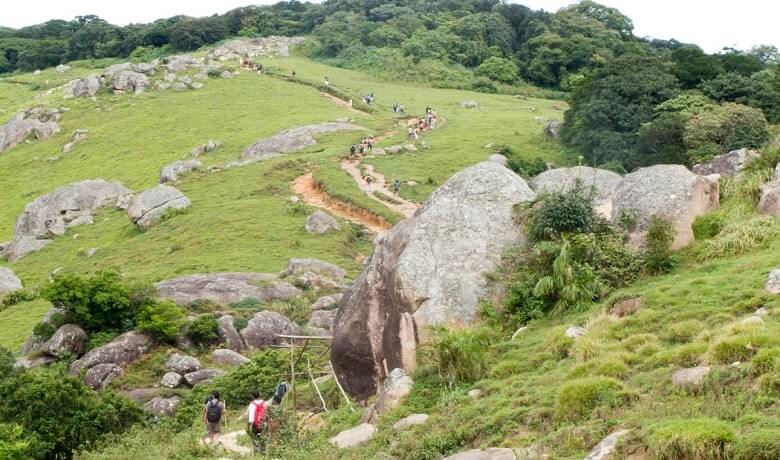- June 5, 2025

Contents
Lord Shiva is always considered as the God of Gods and he is also regarded as the representation of Supreme Being. In India, there were a lot of temples dedicated to the Lord Shiva, who is considered as the important deity of Hinduism. Here, we were about to know about the history of one of the most popular hill temples of the Lord Shiva and that is Velliangiri Temple.
Velliangiri is a place located in the Western Ghats of the western border of the district Coimbatore in Tamil Nadu. The area at the foot of this hill Velliangiri is called as Poondi. There is a beautiful temple at this place Poondi, which is facing east with the shrines of Poondi Ganesha, Lord Velliangiri and the Goddess Manonmani. Recently, a 4 1/2 feet tall ivory statue of Nataraja and a statue of 63 Shiva Devotees were consecrated.
To the north of the temple is the Pancha Ganesha Mandapam with five Ganesha statues. Next is the zodiac pillar made of stone and this is something that cannot be found in any other temples. This structure looks like a fully bloomed lotus flower formed by stacking 9 lotus flowers on its central stalk. At the base of this fully bloomed lotus flower are the 12 zodiac signs neatly carved. At the top is an umbrella with a portrait of a beautiful bird on it.

At the southern tip of the Country, there is a woman who was adamant that she would marry only the Almighty, the Lord Shiva. She decided to make herself worthy for the Lord Shiva. She had set up a dead line, which would be the day that the Lord Shiva would come for her and she also decided that if the Lord Shiva does not show up until that day she would kill herself. On knowing this, the Lord Shiva came in search of her, but he was stopped from reaching her because of a conspiracy and the woman killed herself. It is believed that she still stands as Kanniyakumari, where the virgin temple is located.
Depressed that he could not reach her on time, the Lord Shiva needed a place to dissolve his grief. The Lord Almighty climbed the Velliangiri hills and landed on its summit. Here, he did not sit in bliss, did not sit in meditation because he arrived here in a kind of anger and depression. He spent some considerable time there. The place where the Lord Shiva sat, people called it as Kailayam and this is why the people call Velliangiri hills as South Kailayam.
The Velliangiri Andavar Cave Temple is located on the seventh hill of the Velliangiri Hills, called as Girimalai and is located at an altitude of about 6000 feet at the end of a very steep mountain pass. The temple is located in a densely forested area and the temperature is usually extremely cold. The visit to this temple closes at 6 pm due to the high level of wildlife movement. At the back of the temple, there are steps to go up the hill on the north side.
The Linga on the seventh hill of the Velliangiri Hills is a naturally raised self – made Linga. It is believed that Velliangiri is a place where the sages and the people of wisdom live invisibly in the form of materials. Traveling in it is tantamount to get closer to the Lord Almighty step by step.
Climbing Velliangiri Hill isn’t a normal thing to do. Climbing mountains can be life threatening for people with high blood pressure, diabetes and heart failure, low and high blood pressure and those over 40 years of age. Women under the age of 10 and above the age of 40 should not climb the mountain. Devotees are asked to return to the foothills as soon as they continue to climb the mountain in the event of snowstorms and rains. The bamboo stick used by the crutches is the lifeblood for us as we climb and descend the mountain. These sticks are for sale in the basement.
Devotees visit this hill only till the 15th of the Tamil Months Panguni (Mid – March), Chithirai (Mid – April) and Vaikasi (Mid – Febraury) in the year. The prevailing climate during these months is found to be optimal. Especially on Chitra Pournami, millions of devotees come and visit the temple. It is usually best to climb the mountain at night and reach the foothills before the sun rises. In the summer most of the wildlife goes to the lower reaches in search of water bodies and hence there will be no disturbance of wildlife as the devotees will be traveling at that time.
The statue of the Lord Shiva with his serpent, Lord Ganesha and the Goddess Manonmani were place at the foothills of the temple for the devotees to pray that they should visit the temple and return safely.
Velliangiri has seven hills. Velliangiri is a hill where the hearts of those who love the God and nature are engaged. These seven mountains are considered as the symbol of the seven chakras that are subtle in the human body. While trekking, there are seven ups and downs, which gives the trekker the experience of climbing seven hills and hence the Velliangiri Hills is called as Seven Hills.
The place where the Lord Shiva sat at the Velliangiri Hills, people call it as “Thennadudaya Sivane Potri” and this is why the people call Velliangiri hills as South Kailayam.
The height of the stairs is 3/4 foot to 1 foot, although there were uniform steps throughout the path located on the first hill. As it is dark at night, traveling among the dense oases become difficult despite the moonlight. The hill is rich in bamboo, teak, herbaceous plants and trees. There is no boredom in chanting the mantra of Om Namah Shivaya in the most difficult environment while climbing the mountain.
The cool breeze that blows with the scent of the herb, the pleasant atmosphere of traveling between the oases, the soft sound of birds and beetles wafting off can only be described by the characters as a pleasant experience to the body and soul. The aroma of the herbaceous plants, the aroma of the flowers, and the breath of the pure air bring health to the body. Only the first of the seven mountains is high. About 1 1/2 km. Will be. There is a white Ganesha shrine at the beginning of the second hill over the first hill.

The second hill has plains and steps in a few places. To get used to the journey, drink the water in the swamp and as we continue walking excitedly on the second mountain, at the end of it is a slippery rock. Climbing this rock is difficult. The hill is rich in pepper and bamboo. At the end of this hill is the Holy Pond (Theertham in Tamil) and is called as Pambatti Sunai.

The third mountain also starts with a swamp and this is called as the Clapping Swamp (Kaithati Sunai). Since it is believed that the Siddhas are nomadic in the areas where this swamp is located, there is a belief that the water will come from the crevices of the rocks if we stand here and clap our hands and hence the name clapping swamp.
The third mountain ends up in another swamp and is also called as the Pambatti Sunai. The only thing that comes to our mind when we say Pambatti Sunai is the Pambatti Siddhar is Maruthamalai. It is believed that the Pambatti Siddhar might have lived in this place as well.

If we come to a place where a kind of gourd grass has grown densely it can be known as the beginning of the fourth mountain. The fourth mountain is flat. This hill is easy to walk and hence serves as an opportunity for the devotees to relax themselves. It is on this fourth hill that the Siddhar Samadhi called Otter Samadhi is located. Hence, the name Otter Samadhi is a well-known name among the devotees of Velliangiri. This mountain is also known as Thiruneeru Malai.

The fifth hill is named as Beeman Kali Urundai Hill. It is believed that the Pancha Pandavas stayed at Tarapuram and came to the Velliangiri Hills at that time. Therefore, there are places like Beeman Kali Urundai Hill and the Arjunan Head Rock which is considered to be the place where Arjunan performed penance. The hill is rich in redwoods and flowering plants. On the north side of the path is a dense forest called as the Sita forest. The area is mostly plain-like without much fluctuations. While traveling in this region, we can feel the wind blowing at high speeds with extreme cold even in summer.
The fifth and sixth mountains are full of ups and downs, close to each other. Between these two hills is the Sethilai Cave. It is worth mentioning that this cave can accommodate up to 60-70 people at a time.

The sixth mountain descend towards the bottom. There is a swamp called as Aandi Sunai. Devotees say that bathing here is an unforgettable and most memorable experience. The Fifth and Sixth Mountains have white sand and hence, they are also known as Thiruneeru Malai. It is the custom of the devotees to take the white sand from this Thiruneeru hill to their homes.

Climbing the seventh hill, called Swami Mudi Hill, was as difficult and challenging as climbing the first hill. On this hill, there are three great rocks, which together are a feast for the eyes with a rare view that is naturally situated. This is called the Thorana Entrance. Beyond this gate is the Lord Ganesha shrine. Next to this is the small cave, where the Goddess Sanctuary is located. Next to this, the Lord Velliangiri Temple is located in a cave located under a large rock. The Lord of the Velliangiri Hills is a naturally raised self-made Linga.
The temple is located at a distance of 40 km on the way to Siruvani from Coimbatore. The temple can be reached by going from Gandhipuram to Iruttuppallam (32 km) and from there to the right (8 km). Buses are available from Gandhipuram to Poondi once in an hour and a half.
The joy and excitement we feel when we reach this temple and stand in front of the Lord Almighty is indescribable. The physical exhaustion, depression and the aching legs that had been climbing the seven mountains will all disappear in a moment when we see and worship the Almighty, the Lord Shiva.